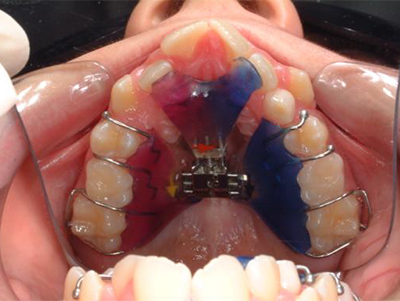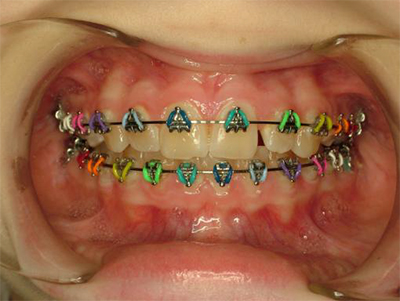Orthopaedic Treatment Bristol
This treatment is at the pinnacle of preventive treatment, to establish a healthy aesthetic dentition which is in good function and, therefore, long lasting and comfortable for life. This is a fundamental part of setting our young patients on the path of “minimal intervention” and healthy mouths for life.
We aim to start treatment as early as necessary, to allow maximum development of the bone, and try to avoid extraction of teeth. Usually treatment begins with removable braces, at around ages 7- 9, to help develop the jaws to the correct size.
Orthodontic straightening of the teeth, using fixed braces (sometimes called “traintracks”), starts at around age 12 when all the adult teeth are through and the baby teeth have fallen out. We offer treatment for adults too, to improve the appearance and function of the teeth.
We can also offer Invisalign and Smile Tru invisible aligners (like a thin, clear gumshield) for some adult cases. This can be a more aesthetic alternative to fixed braces.
Frequently Asked Questions
How does this method differ from other orthodontic treatment?
Our courses of treatment are divided into two phases:
Phase One
The Orthopaedic Phase: Encouraging bone growth to allow more space for the adult teeth to erupt into the mouth.
This is also important because it allows the bones of the skull to function properly, so avoiding:
- Headaches
- Neck pain
- Back problems
- Sinus drainage problems and subsequent infection
- Blocked ears, tinnitus, and infections
- Restricted airways
and allowing:
- A good relationship between the biting surfaces of the teeth
- Health of the jaw joints
- Harmony in the jaw, neck and facial muscles
- Good function of the cranium & spine
- Attractive facial profile
The orthopaedic phase is achieved with plastic and stainless steel wire appliances (removable braces). The design of these will depend on the diagnosis.

Example of a removable orthopaedic appliance

Example of fixed orthodontic appliances
Phase Two
The Orthodontic Phase: Straightening of the teeth within the jaw bones.
This phase almost always follows the orthopaedic phase, to “fine tune” the tooth position by correcting the angulation of the teeth.
This is important to ensure good function of the biting surfaces of the teeth, and long term stability of tooth position.
It is achieved with fixed braces (“train tracks”).
Are tooth extractions ever necessary?
The way we do orthodontics is sometimes called “non-extraction orthodontics”. This is slightly misleading because sometimes it is appropriate to remove teeth. If you are shown to have particularly large teeth in combination with a particular type of bite, then removal of premolars may be appropriate: this is quite rare however.
More commonly, if wisdom teeth are developing, one set of molar teeth may be removed to allow space for the other teeth. Most of us don’t have sufficient space for all 32 teeth in our mouths, so timely removal of one set of molars can prevent problems with impacted wisdom teeth in the future.
How long does the treatment take?
This will depend on how much development of the jaws is required, and the age of the patient. It usually takes longer than “normal” orthodontic treatment, with the average length of treatment being about 18 months - 2 years.
At what age should treatment begin?
Unlike other orthodontic treatments, we do not wait until the baby teeth have all fallen out! Beginning treatment whilst some baby teeth are still in place offers very significant advantages:
- Younger children find wearing braces easy and, often, fun. (Teenagers are less enthusiastic!)
- We can hold open the space that remains once baby teeth are lost- this makes alignment of the adult teeth much easier.
- Development of the jaws is twice as fast before the age of 12, while some baby teeth are still present
We assess children from about age 4 onwards, and then reassess them at every examination, until they have stopped growing.
Certain types of developmental problems should be treated as soon as they are diagnosed (children as young as 4 years have successfully worn braces), but most treatment is started between the ages of 7 - 12 years.
What should I expect from the first visit?
The initial appointment may involve an examination, two large x-rays (and sometimes small ones) and impressions of the mouth. At this stage, a provisional diagnosis will be offered, but the definitive diagnosis can only be known once the x-rays have been traced and analysed.
Your second visit will involve a discussion about all of the results of these investigations. If it is appropriate to start treatment, braces can be fitted at the second visit also.
Can adults have orthodontic treatment too?
Yes, appearance and function can be improved in adults too. However, it will take longer to achieve this past the age of 18. We aim to design appliances that are less visible and lower profile for adult patients.




